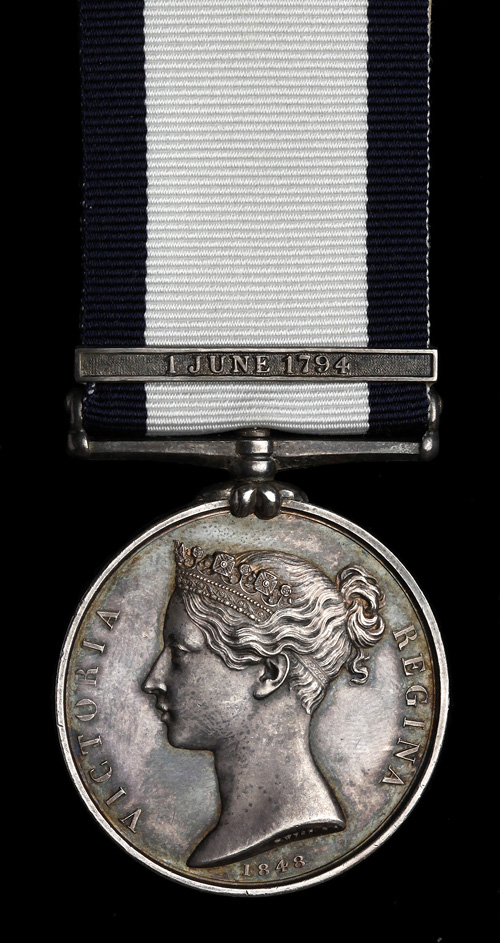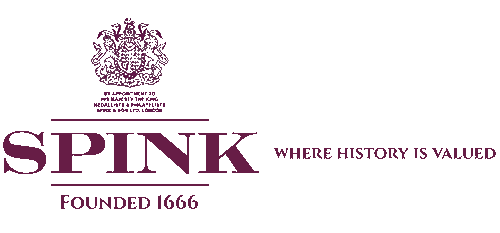
Auction: 1025 - The Turl Collection of Naval General Service Medals 1793 - 1840
Lot: 2
A ´Glorious 1st of June´ Award to Mathew Buckle, Who, As A Young Lieutenant, Was Deprived of the Use of His Limbs By Rheumatism and is Recorded as Efficiently Discharging His Duty During the Battle by Being Carried About in the Arms of a Seaman. From His Earliest Appointment as Captain´s Servant, When He Entered the Royal Navy in 1777, Aged 6 Years, To His Final Advancement to Admiral in 1852, Mathew Buckle Had Been Retained On Royal Naval Records For 75 Years Naval General Service 1793-1840, one clasp, 1 June 1794 (Mathew Buckle, Lieut.), extremely fine Estimate £ 5,000-7,000 Mathew Buckle served as Lieutenant in H.M.S. Royal Sovereign for the fleet action that became known as ´The Glorious First of June´. A total of seven Large Naval Gold Medals and 15 Small Naval Gold Medals were awarded for this action. Admiral Matthew Buckle (1770-1855), born at Nork House, Banstead, Surrey; the son of Admiral of the Blue Matthew Buckle; joined the Royal Navy in 1777 and aged 6 years old was posted as Captain´s Servant in H.M.S. Dispatch (Captain C. Mason); removed with Captain Mason to H.M.S. Delaware, and served off the coast of North America until November 1779; borne on the Ship´s Books of H.M.S. Salisbury (Commodore John Elliot) as Able Seaman, from which he was employed off Newfoundland, from April 1786; Midshipman, June 1787; Lieutenant, January 1791; saw service in H.M. Ships Centurion, Diana, and Falcon before being appointed to H.M.S. Royal Sovereign (bearing the flags successively of Vice-Admiral T. Graves and Rear-Admiral Hon. W. Cornwallis), February 1793; Admiral Graves was second-in-command of the Channel Fleet under Admiral Lord Howe, and Buckle was present with the former in Lord Howe´s actions against the French on the 29th May and the 1st of June 1794; at the latter action Buckle is recorded as ´although being deprived by rheumatism of the use of his limbs, he continued most efficiently to discharge his duty at his quarters, the after-half of the lower-deck, by causing himself to be carried about in the arms of a seaman´ (O´Byrne refers); after a posting to H.M.S. Marlborough Buckle was appointed to the command of H.M. Sloop Ferret, December 1796, before being appointed to the command of H.M. Storeship Camel; whilst in the latter capacity, Robert Stocker, Master of the James and Mary of Blythe gives the following account of Buckle´s gallant conduct, ´Deserted and left to our fate by several Merchant vessels that past us... we had given up all hope and were endeavouring to reconcile ourselves to the fate that seemed to await us. H.M. Storeship Camel hove in sight and with a readiness highly honourable to the feelings of humanity of Captain Buckel, immediately came down to us...... Thus by the humanity of Captain Buckle.... I and eight more have been preserved to our families and Country´ (Buckle Papers refer); after service on the Jamaica and Halifax stations he was appointed Superintendent to the Portsmouth district of Sea Fencibles, May 1804; subsequently served as Captain of the Adamant and the Latona on the Leith station, 1810-1813; failing eye sight limited his opportunities to command and he was placed on the retired list as Rear-Admiral; by 1833 Buckle was totally blind; his last appointment as Admiral in 1852 marked 75 years of service in the Royal Navy.
Sold for
£5,800




